HP Pavilion 14 (Intel, 14-ab000 Maintenance and Service Guide

HP Pavilion 14 Notebook PC (Intel, model numbers 14-ab000 through 14-ab099)
Maintenance and Service Guide
© Copyright 2015 HP Development Company,
L.P.
Bluetooth is a trademark owned by its proprietor and used by HP Inc. under license. Intel and Core are trademarks of Intel Corporation in the U.S. and other countries. Microsoft and Windows are U.S. registered trademarks of Microsoft Corporation.
Product notice
This guide describes features that are common to most models. Some features may not be available on your computer.
Not all features are available in all editions of Windows 8. This computer may require upgraded and/or separately purchased hardware, drivers and/or software to take full advantage of Windows 8 functionality. See http://www.microsoft.com for details.
The information contained herein is subject to change without notice. The only warranties for HP products and services are set forth in
the express warranty statements accompanying such products and services. Nothing herein should be construed as constituting an additional warranty. HP shall not be liable for technical or editorial errors or omissions contained herein.
Second Edition: September 2015
First Edition: April 2015
Document Part Number: 807012-002

Important Notice about Customer Self-Repair Parts
 CAUTION: Your computer includes Customer Self-Repair parts and parts that should only be accessed by an authorized service provider. See Chapter 5, "Removal and replacement procedures for Customer Self-Repair parts," for details. Accessing parts described in Chapter 6, "Removal and replacement procedures for Authorized Service Provider only parts," can damage the computer or void your warranty.
CAUTION: Your computer includes Customer Self-Repair parts and parts that should only be accessed by an authorized service provider. See Chapter 5, "Removal and replacement procedures for Customer Self-Repair parts," for details. Accessing parts described in Chapter 6, "Removal and replacement procedures for Authorized Service Provider only parts," can damage the computer or void your warranty.
iii
iv Important Notice about Customer Self-Repair Parts

Safety warning notice
 WARNING! To reduce the possibility of heat-related injuries or of overheating the device, do not place
WARNING! To reduce the possibility of heat-related injuries or of overheating the device, do not place
the device directly on your lap or obstruct the device air vents. Use the device only on a hard, flat surface. Do not allow another hard surface, such as an adjoining optional printer, or a soft surface, such as pillows or rugs or clothing, to block airflow. Also, do not allow the AC adapter to contact the skin or a soft surface, such as pillows or rugs or clothing, during operation. The device and the AC adapter comply with the useraccessible surface temperature limits defined by the International Standard for Safety of Information Technology Equipment (IEC 60950-1).
v
vi Safety warning notice

Table of contents
1 Product description ....................................................................................................................................... |
1 |
2 External component identification ................................................................................................................. |
4 |
Right side ............................................................................................................................................................... |
4 |
Left side ................................................................................................................................................................. |
6 |
Display ................................................................................................................................................................... |
8 |
Top ....................................................................................................................................................................... |
11 |
TouchPad ........................................................................................................................................... |
11 |
Lights ................................................................................................................................................. |
12 |
Buttons, speakers, and fingerprint reader (select models only) ..................................................... |
13 |
Keys ................................................................................................................................................... |
14 |
Bottom ................................................................................................................................................................. |
15 |
3 Illustrated parts catalog .............................................................................................................................. |
16 |
Locating system information .............................................................................................................................. |
16 |
Computer major components ............................................................................................................................. |
17 |
Display assembly subcomponents (non-TouchScreen; select models only) .................................................... |
23 |
Display assembly subcomponents (TouchScreen; select models only) ............................................................ |
25 |
Miscellaneous parts ............................................................................................................................................. |
26 |
4 Removal and replacement procedures preliminary requirements .................................................................... |
27 |
Tools required ...................................................................................................................................................... |
27 |
Service considerations ........................................................................................................................................ |
27 |
Plastic parts ....................................................................................................................................... |
27 |
Cables and connectors ...................................................................................................................... |
27 |
Drive handling ................................................................................................................................... |
28 |
Grounding guidelines ........................................................................................................................................... |
29 |
Electrostatic discharge damage ....................................................................................................... |
29 |
Packaging and transporting guidelines ......................................................................... |
30 |
Workstation guidelines ................................................................................................... |
30 |
Equipment guidelines ..................................................................................................... |
31 |
5 Removal and replacement procedures for Customer Self-Repair parts ............................................................. |
32 |
Component replacement procedures ................................................................................................................. |
32 |
Battery ............................................................................................................................................... |
32 |
Optical drive ...................................................................................................................................... |
33 |
vii
6 Removal and replacement procedures for Authorized Service Provider parts ................................................... |
35 |
Component replacement procedures ................................................................................................................. |
35 |
Computer feet ................................................................................................................................... |
35 |
Base enclosure .................................................................................................................................. |
36 |
Hard drive .......................................................................................................................................... |
38 |
Memory module ................................................................................................................................ |
40 |
WLAN module .................................................................................................................................... |
41 |
Fan ..................................................................................................................................................... |
43 |
Connector board ................................................................................................................................ |
44 |
System board .................................................................................................................................... |
45 |
Heat sink (with discrete memory) ..................................................................................................... |
50 |
Heat sink (with UMA memory) (select models only) ........................................................................ |
52 |
TouchPad ........................................................................................................................................... |
54 |
Removing the display ........................................................................................................................ |
56 |
Speakers ............................................................................................................................................ |
58 |
Power connector cable ...................................................................................................................... |
59 |
Power button board .......................................................................................................................... |
60 |
Display assembly (non-TouchScreen) (select models only) ............................................................ |
61 |
Display assembly (TouchScreen) (select models only) .................................................................... |
66 |
7 Using Setup Utility (BIOS) – Windows 10 ........................................................................................................ |
71 |
Starting Setup Utility (BIOS) ................................................................................................................................ |
71 |
Updating Setup Utility (BIOS) .............................................................................................................................. |
71 |
Determining the BIOS version ........................................................................................................... |
72 |
Downloading a BIOS update .............................................................................................................. |
72 |
Synchronizing a tablet and keyboard (select products only) ............................................................................. |
73 |
8 Using HP PC Hardware Diagnostics (UEFI) – Windows 10 .................................................................................. |
74 |
Downloading HP PC Hardware Diagnostics (UEFI) to a USB device .................................................................... |
75 |
9 Using Setup Utility (BIOS) and HP PC Hardware Diagnostics (UEFI) – Windows 8 ................................................ |
76 |
Using Setup Utility (BIOS) .................................................................................................................................... |
76 |
Starting Setup Utility (BIOS) .............................................................................................................. |
76 |
Updating Setup Utility (BIOS) ............................................................................................................ |
76 |
Determining the BIOS version ........................................................................................ |
76 |
Downloading a BIOS update ........................................................................................... |
77 |
Using HP PC Hardware Diagnostics (UEFI) .......................................................................................................... |
78 |
Downloading HP PC Hardware Diagnostics (UEFI) to a USB device .................................................. |
78 |
viii
10 Using Setup Utility (BIOS) and System Diagnostics – Windows 7 .................................................................... |
79 |
Starting Setup Utility (BIOS) ................................................................................................................................ |
79 |
Updating the BIOS ................................................................................................................................................ |
79 |
Determining the BIOS version ........................................................................................................... |
79 |
Downloading a BIOS update .............................................................................................................. |
80 |
Using HP PC Hardware Diagnostics (UEFI) .......................................................................................................... |
81 |
Downloading HP PC Hardware Diagnostics (UEFI) to a USB device .................................................. |
81 |
11 Specifications ........................................................................................................................................... |
82 |
Computer specifications ...................................................................................................................................... |
82 |
12 Backing up, restoring, and recovering – Windows 10 ..................................................................................... |
83 |
Creating recovery media and backups ................................................................................................................ |
83 |
Creating HP Recovery media (select products only) ........................................................................ |
84 |
Using Windows Tools ........................................................................................................................................... |
85 |
Restore and recovery .......................................................................................................................................... |
85 |
Recovering using HP Recovery Manager .......................................................................................... |
86 |
What you need to know before you get started ............................................................ |
86 |
Using the HP Recovery partition (select products only) ................................................ |
87 |
Using HP Recovery media to recover ............................................................................. |
87 |
Changing the computer boot order ................................................................................ |
88 |
Removing the HP Recovery partition (select products only) ......................................... |
88 |
13 Backing up, restoring, and recovering – Windows 8 ...................................................................................... |
89 |
Creating recovery media and backups ................................................................................................................ |
89 |
Creating HP Recovery media (select models only) ........................................................................... |
89 |
Using Windows tools ........................................................................................................................................... |
90 |
Restore and recovery .......................................................................................................................................... |
90 |
Recovering using HP Recovery Manager .......................................................................................... |
91 |
What you need to know before you get started ............................................................ |
91 |
Using the HP Recovery partition (select models only) .................................................. |
92 |
Using HP Recovery media to recover ............................................................................. |
92 |
Changing the computer boot order ................................................................................ |
92 |
Removing the HP Recovery partition (select models only) ........................................... |
93 |
14 Backing up, restoring, and recovering – Windows 7 ...................................................................................... |
94 |
Creating backups ................................................................................................................................................. |
94 |
Creating recovery media to recover the original system ................................................................. |
94 |
What you need to know .................................................................................................. |
94 |
Creating the recovery media ........................................................................ |
95 |
ix
Creating system restore points ........................................................................................................ |
95 |
What you need to know .................................................................................................. |
95 |
Creating a system restore point ..................................................................................... |
95 |
Backing up system and personal information .................................................................................. |
95 |
Tips for a successful backup ........................................................................................... |
96 |
What you need to know .................................................................................................. |
96 |
Creating a backup using Windows Backup and Restore ................................................ |
96 |
Restore and recovery .......................................................................................................................................... |
97 |
Restoring to a previous system restore point .................................................................................. |
97 |
Restoring specific files ...................................................................................................................... |
97 |
Restoring specific files using Windows Backup and Restore ......................................... |
97 |
Recovering the original system using HP Recovery Manager .......................................................... |
97 |
What you need to know .................................................................................................. |
97 |
Recovering using HP Recovery partition (select models only) ...................................... |
98 |
Recovering using the recovery media ............................................................................ |
98 |
Changing the computer boot order .............................................................. |
98 |
15 Power cord set requirements .................................................................................................................... |
100 |
Requirements for all countries ......................................................................................................................... |
100 |
Requirements for specific countries and regions ............................................................................................. |
100 |
16 Recycling ................................................................................................................................................ |
102 |
Index ........................................................................................................................................................... |
103 |
x

1Product description
Category |
Description |
|
|
|
|
Product Name |
HP Pavilion Notebook PC (Intel, model numbers 14-ab000 through 14-ab099) |
|
|
|
|
Processors |
● |
Intel™ Core®i7-6500U 2.50-GHz (SC turbo up to 3.00-GHz) processor (1600-MHz FSB, 4.00-MB L3 |
|
|
cache, dual core, 15 W) |
|
● |
Intel Core i7-5500U 2.40-GHz (SC turbo up to 3.00-GHz) processor (1600-MHz FSB, 4.00-MB L3 cache, |
|
|
dual core, 15 W) |
|
● |
Intel Core i5-6200U 2.30-GHz (SC turbo up to 2.80-GHz) processor (1600-MHz FSB, 3.00-MB L3 cache, |
|
|
dual core, 15 W) |
|
● |
Intel Core i5-5200U (2.20-GHz, SC turbo up to 2.70-GHz) processor (1600-MHz FSB, 3.00-MB L3 cache, |
|
|
dual core, 15 W) |
|
● |
Intel Core i3-6100U 2.30-GHz processor (1600-MHz FSB, 3.00-MB L3 cache, dual core, 15 W) |
|
● |
Intel Core i3-5020U 2.20-GHz processor (1600-MHz FSB, 3.00-MB L3 cache, dual core, 15 W) |
|
● |
Intel Core i3-5010U 2.00-GHz processor (1600-MHz FSB, 3.00-MB L3 cache, dual core, 15 W) |
|
|
|
Chipset |
Intel Wildcat Point-LP processor controlled hub (PCH) |
|
|
|
|
Graphics |
Internal graphics: |
|
|
● |
Intel HD Graphics 5500 |
|
External graphics: |
|
|
● |
NVIDIA® N16S-GT (GeForce 940M) with up to 2048-MB of dedicated video memory (256Mx16 DDR3 |
|
|
900-MHz × 4 PCs, 1GHz bridge to 900-MHz) |
|
● |
AMD® R7 M360 (Meso-XT) with up to 2048-MB of dedicated video memory (256Mx16 DDR3 900-MHz × |
|
|
4 PCs, 1GHz bridge to 900-MHz) |
|
|
|
Panel |
● |
14.0” [35.5 cm] (1366×768), high definition (eDP), light-emitting diode (LED), BrightView, 16:9 |
|
|
UltraWide Aspect Ratio, 220 nits |
|
● |
14.0” [35.5 cm] (1366×768), high definition (eDP), light-emitting diode (LED), BrightView, 16:9 |
|
|
UltraWide Aspect Ratio, touch on panel (TOP), 200 nits |
|
Touch solution with flush glass, multitouch enabled |
|
|
Supports low-voltage differential signaling (LVDS) (co-layout with eDP 1.2) |
|
|
|
|
Memory |
16384 MB (8192 MB × 2) |
|
|
12288 MB (8192 MB +4096 MB) |
|
|
8192 MB (8192 MB × 1) |
|
|
8192 MB (4096 MB × 2) |
|
|
6144 MB (2048 MB × 1 + 4096 MB × 1) |
|
|
4096 MB (4096 MB × 1) |
|
|
4096 MB (2048 MB × 2) |
|
|
|
|
Hard drive |
2 TB (5400) 9.5mm |
|
|
1 TB (5400) 9.5mm |
|
1

Category |
Description |
|
|
|
|
|
750 GB (5400) 9.5mm |
|
|
500 GB (5400) 7mm/9.5mm |
|
|
1 TB (5400) + 8 GB NAND Hybrid HDD 9.5mm |
|
|
|
|
Optical drive |
DVD±RW Double-Layer SuperMulti drive |
|
|
Support for Zero-Power ODD |
|
|
Support for M-disc |
|
|
Support for external 9.5 mm tray load, SATA, DVD±RW DL SuperMulti drive |
|
|
|
|
Audio and video |
Integrated HP TrueVision camera: HD (1280×720 by 30 frames/sec), fixed (no tilt), with activity light |
|
|
Dual digital microphones with appropriate software - echo cancellation, noise suppression |
|
|
Dual speakers |
|
|
|
|
Ethernet |
Integrated 10/100 NIC |
|
|
|
|
Wireless |
Integrated Wireless options: |
|
|
● |
Broadcom BCM943142 802.11 bgn 1×1 Wi-Fi + Bluetooth 4.0 M.2 Combo Adapter |
|
● |
Intel 3165NGWG ac 1×1 + Bluetooth 4.0 LE PCIe+USB NGFF 2230 Combo Adapter |
|
● |
Intel Dual Band Wireless-AC 3160 802.11 ac 1×1 WiFi + Bluetooth 4.0 Combo Adapter |
|
● |
Realtek RTL8188EE 802.11 bgn Wi-Fi Adapter |
|
|
|
External media cards |
HP Multi-Format Digital Media Card Reader with push-push technology. Supports SD/SDHC/SDXC. |
|
|
|
|
Ports |
AC adapter: HP Smart pin plug (4.5mm barrel) |
|
|
Audio: one combo audio-out (headphone)/audio-in (microphone) jack |
|
|
HDMI: v. 1.4 supporting up to 1080p, 1920x1080 at 60Hz |
|
|
RJ-45/Ethernet |
|
|
(2) USB 3.0 (1 on the left side, 1 on the right side) |
|
|
(1) USB 2.0 (left side) |
|
|
|
|
Keyboard/pointing |
● |
Full size standard textured island-style keyboard with numeric keypad |
devices |
● |
Full size standard dura coat island-style backlit keyboard with numeric keypad |
|
||
|
Clickpad requirements: |
|
|
● |
Multitouch gestures enabled |
|
● |
Support for Windows 8.1 Modern TouchPad gestures |
|
● |
Taps enabled as default |
|
|
|
Power requirements |
Supports the following Smart AC power adapters: |
|
|
● |
45 W |
|
● |
65 W |
|
● |
65 W EM |
|
● |
65 W Slim Travel adapter |
1 meter power cord
Supports the following batteries:
2Chapter 1 Product description

Category |
Description |
|
|
|
|
|
● |
4-cell battery, 48-Whr, Li-ion battery |
|
● |
4-cell battery, 41-Whr, Li-ion battery |
|
|
|
Security |
Security cable slot |
|
|
Trusted platform module (TPM) 2.0 support |
|
|
|
|
Operating system |
Preinstalled: |
|
|
● |
Windows 10 |
|
● |
Windows 8.1 |
|
● |
Windows 7 Professional |
|
|
|
Serviceability |
End user replaceable parts: |
|
|
● |
Optical drive |
|
● |
Battery |
|
● |
AC Adapter |
|
|
|
3

2External component identification
Right side
Component |
|
Description |
|
|
|
|
|
(1) |
Power light |
● |
On: The computer is on. |
|
|
● |
Blinking: The computer is in the Sleep state, a power- |
|
|
|
saving state. The computer shuts off power to the display |
|
|
|
and other components. |
|
|
● |
Off: The computer is off or in Hibernation. Hibernation is a |
|
|
|
power-saving state that uses the least amount of power. |
|
|
|
|
(2) |
Hard drive/optical drive light |
● |
Blinking white: The hard drive or optical drive is being |
|
|
|
accessed. |
|
|
● |
Amber: HP 3D DriveGuard has temporarily parked the hard |
|
|
|
drive. |
|
|
|
|
(3) |
Audio-out (headphone)/Audio-in (microphone) |
Connects optional powered stereo speakers, headphones, |
|
|
jack |
earbuds, a headset, or a television audio cable. Also connects an |
|
|
|
optional headset microphone. This jack does not support |
|
|
|
optional microphone-only devices. |
|
|
|
NOTE: When a device is connected to the jack, the computer |
|
|
|
speakers are disabled. |
|
|
|
NOTE: Be sure that the device cable has a 4-conductor |
|
|
|
connector that supports both audio-out (headphone) and audio- |
|
|
|
in (microphone). |
|
|
|
WARNING! To reduce the risk of personal injury, adjust |
|
|
|
the volume before putting on headphones, earbuds, or a |
|
|
|
headset. For additional safety information, refer to |
|
|
|
the Regulatory, Safety, and Environmental Notices. |
|
|
|
To access this document: |
|
|
|
Windows 10: |
|
|
|
1. |
Type support in the taskbar search box, and then select |
|
|
|
the HP Support Assistant app. |
– or –
Click the question mark icon in the taskbar.
4Chapter 2 External component identification

2. Select My PC, select the Specifications tab, and then
|
|
select User Guides. |
|
|
Windows 8: |
|
|
▲ From the Start screen, type support, and then select the |
|
|
HP Support Assistant app. |
|
|
– or – |
|
|
From the Windows desktop, click the question mark icon in |
|
|
the notification area, at the far right of the taskbar. |
|
|
Windows 7: |
|
|
▲ Select Start > Help and Support > User Guides. |
|
|
|
(4) |
USB 3.0 port |
Connects an optional USB device, such as a keyboard, mouse, |
|
|
external drive, printer, scanner or USB hub. |
|
|
|
(5) |
HDMI port |
Connects an optional video or audio device, such as a high- |
|
|
definition television, any compatible digital or audio |
|
|
component, or a high-speed High-Definition Multimedia |
|
|
Interface (HDMI) device. |
|
|
|
(6) |
Vents (2) |
Enable airflow to cool internal components. |
|
|
NOTE: The computer fan starts up automatically to cool |
|
|
internal components and prevent overheating. It is normal for |
|
|
the internal fan to cycle on and off during routine operation. |
|
|
|
(7) |
Security cable slot |
Attaches an optional security cable to the computer. |
|
|
NOTE: The security cable is designed to act as a deterrent, but |
|
|
it may not prevent the computer from being mishandled or |
|
|
stolen. |
|
|
|
Right side |
5 |
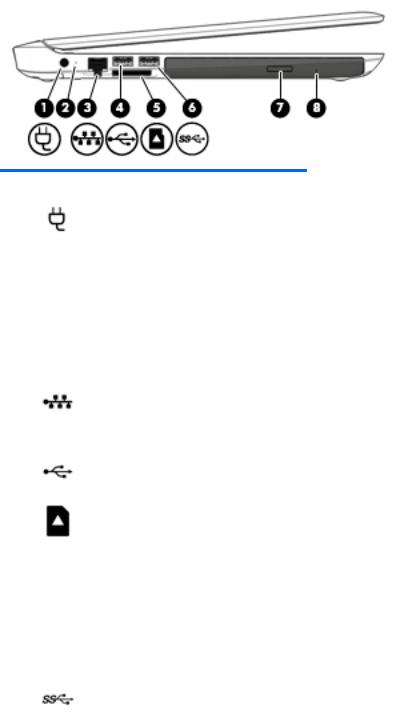
Left side
Component |
|
Description |
|
|
|
|
|
(1) |
Power connector |
Connects an AC adapter. |
|
|
|
|
|
(2) |
AC adapter/battery light |
● |
White: The AC adapter is connected and the battery is fully |
|
|
|
charged. |
|
|
● |
Blinking white: The AC adapter is disconnected and |
|
|
|
the battery has reached a low battery level. |
|
|
● |
Amber: The AC adapter is connected and the battery is |
|
|
|
charging. |
|
|
● |
Off: The battery is not charging. |
|
|
|
|
(3) |
RJ-45 (network) jack/status lights |
Connects a network cable. |
|
|
|
● |
White: The network is connected. |
|
|
● |
Amber: Activity is occurring on the network. |
|
|
|
|
(4) |
USB 2.0 port |
Connects an optional USB device, such as a keyboard, mouse, |
|
|
|
external drive, printer, scanner or USB hub. |
|
|
|
|
|
(5) |
Memory card reader |
Reads optional memory cards that enable you to store, manage, |
|
|
|
share or access information. |
|
|
|
To insert a card: |
|
|
|
1. |
Hold the card label-side up, with connectors facing |
|
|
|
the computer. |
|
|
2. |
Insert the card into the slot, and then push in on the card |
|
|
|
until it is firmly seated. |
|
|
To remove a card: |
|
|
|
▲ |
Press in on the card until it pops out. |
|
|
|
|
(6) |
USB 3.0 port |
Connects an optional USB device, such as a keyboard, mouse, |
|
|
|
external drive, printer, scanner or USB hub. |
|
|
|
|
|
(7) |
Optical drive eject button |
Releases the disc tray. |
|
|
|
|
|
(8) |
Optical drive |
Depending on your computer model, reads an optical disc or |
|
|
|
reads and writes to an optical disc. |
|
6Chapter 2 External component identification

Component |
Description |
|
|
|
NOTE: For disc compatibility information, go to the Help and |
|
Support web page. Follow the web page instructions to select |
|
your computer model. Select Drivers & Downloads, and then |
|
follow the on-screen instructions. |
|
|
Left side |
7 |
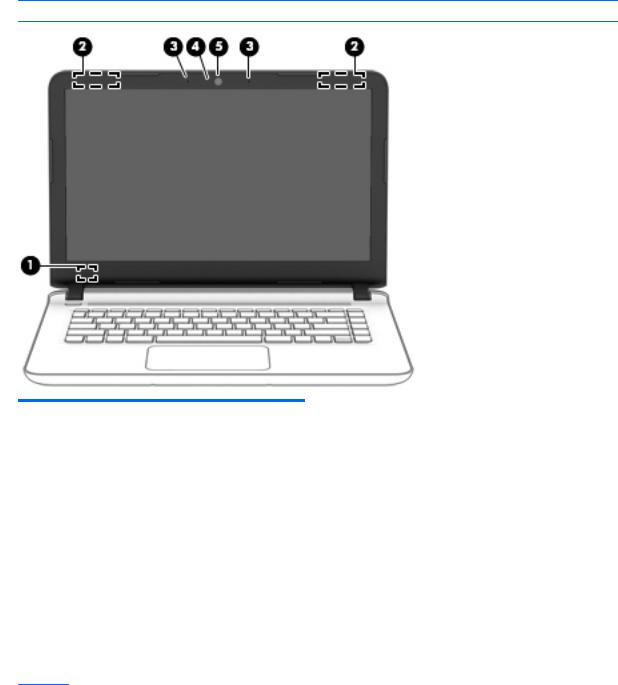
Display
 NOTE: Refer to the illustration that most closely matches your computer.
NOTE: Refer to the illustration that most closely matches your computer.
Component |
Description |
|
|
|
|
(1) |
Internal display switch |
Turns off the display and initiates Sleep if the display is closed while |
|
|
the power is on. |
|
|
NOTE: The internal display switch is not visible from the outside of |
|
|
the computer. |
|
|
|
(2) |
WLAN antennas* |
Send and receive wireless signals to communicate with wireless local |
|
|
area networks (WLANs). |
|
|
|
(3) |
Internal microphones (2) |
Record sound. |
|
|
|
(4) |
Webcam light |
On: The webcam is in use. |
|
|
|
(5) |
Webcam |
Records video and captures photographs. Some models allow you to |
video conference and chat online using streaming video. To use the webcam:
▲ To use the webcam, select Start > All Programs > Communications and Chat > CyberLink YouCam.
NOTE: The antennas are not visible from the outside of the computer. For optimal transmission, keep the areas immediately around the antennas free from obstructions. For wireless regulatory notices, see the section of the Regulatory, Safety, and Environmental Notices that applies to your country or region.
To access this document:
Windows 10:
1.Type support in the taskbar search box, and then select the HP Support Assistant app.
– or –
8Chapter 2 External component identification

Component |
Description |
Click the question mark icon in the taskbar.
2.Select My PC, select the Specifications tab, and then select User Guides.
Windows 8 or Windows 7:
▲Select the HP Support Assistant app on the Start screen, select My computer, and then select User guides.
Component |
Description |
|
|
|
|
(1) |
Internal display switch |
Turns off the display and initiates Sleep if the display is closed while |
|
|
the power is on. |
|
|
NOTE: The internal display switch is not visible from the outside of |
|
|
the computer. |
|
|
|
(2) |
Internal microphones (2) |
Record sound. |
|
|
|
(3) |
Webcam light |
On: The webcam is in use. |
|
|
|
(4) |
Webcam |
Records video and captures photographs. Some models allow you to |
video conference and chat online using streaming video. To use the webcam:
Windows 10: Type camera in the taskbar search box, and then select Camera.
Windows 8:
▲ To use the webcam or 3D camera:
From the Start screen, type camera, and then select Camera from the list of applications.
Display 9

Component |
Description |
|
|
|
|
|
|
Windows 7: For information on using the webcam, select Start > All |
|
|
Programs > Communication and Chat > Cyberlink YouCam. |
|
|
|
(5) |
WLAN antennas* |
Send and receive wireless signals to communicate with wireless local |
|
|
area networks (WLANs). |
*The antennas are not visible from the outside of the computer. For optimal transmission, keep the areas immediately around the antennas free from obstructions. For wireless regulatory notices, see the section of the Regulatory, Safety, and Environmental Notices that applies to your country or region.
To access this guide, select Start > HP Support Assistant > Next > My computer > User Guides.
10 Chapter 2 External component identification

Top
TouchPad
Component |
|
Description |
|
|
|
(1) |
TouchPad zone |
Reads your finger gestures to move the pointer or activate |
|
|
items on the screen. |
|
|
|
(2) |
Left TouchPad button |
Functions like the left button on an external mouse. |
|
|
|
(3) |
Right TouchPad button |
Functions like the right button on an external mouse. |
|
|
|
Top 11
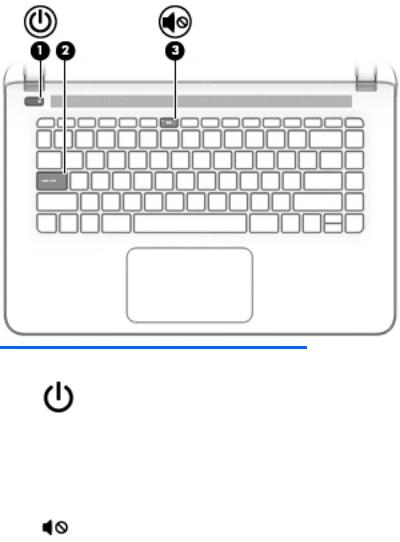
Lights
Component |
|
Description |
|
|
|
|
|
(1) |
Power light |
● |
On: The computer is on. |
|
|
● |
Blinking: The computer is in the Sleep state, a power- |
|
|
|
saving state. The computer shuts off power to the display |
|
|
|
and other unneeded components. |
|
|
● |
Off: The computer is off or in Hibernation. Hibernation is a |
|
|
|
power-saving state that uses the least amount of power. |
|
|
|
|
(2) |
Caps lock light |
On: Caps lock is on, which switches the keys to all capital letters. |
|
|
|
|
|
(3) |
Mute light |
● |
Amber: Computer sound is off. |
|
|
● |
Off: Computer sound is on. |
|
|
|
|
12 Chapter 2 External component identification
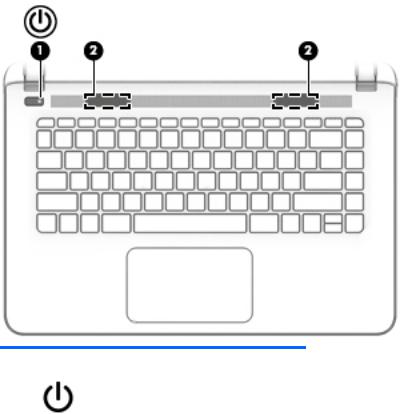
Buttons, speakers, and fingerprint reader (select models only)
Component |
|
Description |
|
|
|
|
|
(1) |
Power button |
● |
When the computer is off, press the button to turn on |
|
|
|
the computer. |
|
|
● |
When the computer is on, press the button briefly to |
|
|
|
initiate Sleep. |
|
|
● |
When the computer is in the Sleep state, press the button |
|
|
|
briefly to exit Sleep. |
|
|
● |
When the computer is in Hibernation, press the button |
|
|
|
briefly to exit Hibernation. |
|
|
CAUTION: Pressing and holding down the power button will |
|
|
|
result in the loss of unsaved information. |
|
|
|
If the computer has stopped responding and Windows shutdown |
|
|
|
procedures are ineffective, press and hold the power button |
|
|
|
down for at least 5 seconds to turn off the computer. |
|
|
|
|
|
(2) |
Speakers (2) |
Produce sound. |
|
|
|
|
|
Top 13
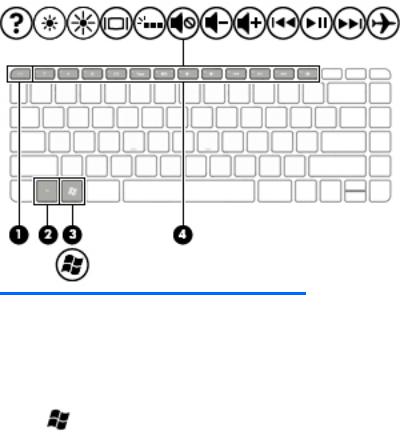
Keys
Component |
|
Description |
|
|
|
(1) |
esc key |
Displays system information when pressed in combination with |
|
|
the fn key. |
|
|
|
(2) |
fn key |
Displays system information when pressed in combination with |
|
|
the esc key. |
|
|
|
(3) |
Windows key |
Displays the Windows Start menu. |
|
|
|
(4) |
Action keys |
Execute frequently used system functions. |
|
|
NOTE: On select models, the f5 action key turns the radiance |
|
|
backlight keyboard feature off or on. |
|
|
|
14 Chapter 2 External component identification
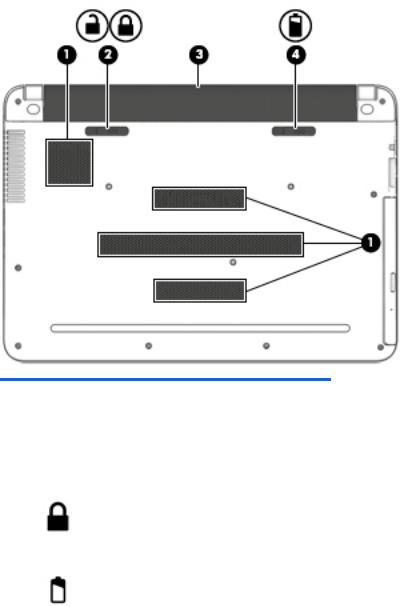
Bottom
Component |
|
Description |
|
|
|
(1) |
Vents (4) |
Enable airflow to cool internal components. |
|
|
NOTE: The computer fan starts up automatically to cool |
|
|
internal components and prevent overheating. It is normal |
|
|
for the internal fan to cycle on and off during routine |
|
|
operation. |
|
|
|
(2) |
Battery lock |
Locks the battery in the battery bay. |
|
|
|
(3) |
Battery bay |
Holds the battery. |
|
|
|
(4) |
Battery release latch |
Releases the battery. |
|
|
|
Bottom 15
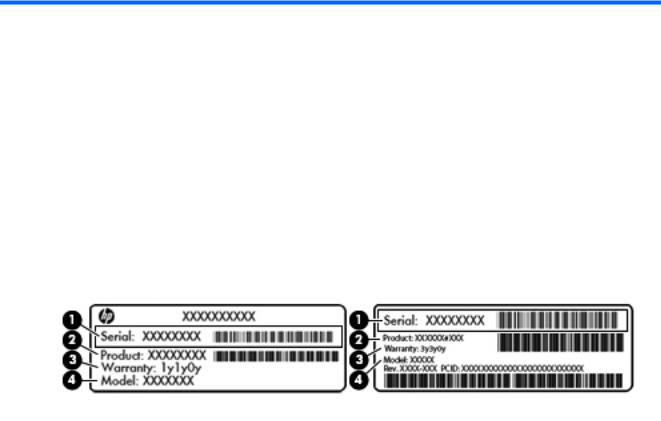
3Illustrated parts catalog
Locating system information
Important system information is located on the bottom of the computer. This information may be needed when travelling internationally or when contacting support.
(1): Serial number
(2): Product number
(3): Model number
(4): Warranty period
Using Windows, briefly press the fn+esc key combination to display the System Information screen, which provides the product name and serial number of your computer, as well as information about the memory, processor, BIOS, and keyboard.
16 Chapter 3 Illustrated parts catalog
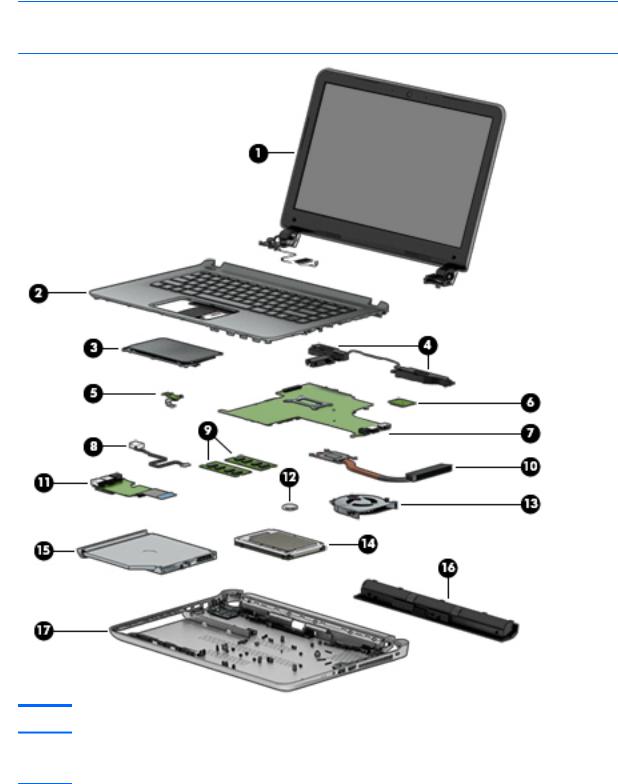
Computer major components
 NOTE: HP continually improves and changes product parts. For complete and current information on supported parts for the computer, go to http://partsurfer.hp.com, select the country or region, and then follow the on-screen instructions.
NOTE: HP continually improves and changes product parts. For complete and current information on supported parts for the computer, go to http://partsurfer.hp.com, select the country or region, and then follow the on-screen instructions.
Item |
Component |
Spare part number |
(1)Display assembly: For display assembly spare part information for non-TouchScreen models, see Display assembly (nonTouchScreen) (select models only) on page 61. For TouchScreen models, see Display assembly (TouchScreen) (select models only) on page 66
(2) |
Keyboard/top cover without backlight: |
|
|
|
|
|
For use in Belgium |
806756-A41 |
|
|
|
Computer major components 17

Item |
Component |
Spare part number |
|
|
|
|
For use in Bulgaria |
806756-261 |
|
|
|
|
For use in Canada |
806756-DB1 |
|
|
|
|
For use in the Czech Republic and Slovakia |
806756-FL1 |
|
|
|
|
For use in Denmark, Finland, and Norway |
806756-DH1 |
|
|
|
|
For use in France |
806756-051 |
|
|
|
|
For use in Germany |
806756-041 |
|
|
|
|
For use in Greece |
806756-151 |
|
|
|
|
For use in Hungary |
806756-211 |
|
|
|
|
For use in Israel |
806756-BB1 |
|
|
|
|
For use in Italy |
806756-061 |
|
|
|
|
For use in Latin America |
806756-161 |
|
|
|
|
For use in the Netherlands |
806756-B31 |
|
|
|
|
For use in Portugal |
806756-131 |
|
|
|
|
For use in Romania |
806756-271 |
|
|
|
|
For use in Slovenia |
806756-BA1 |
|
|
|
|
For use in Spain |
806756-071 |
|
|
|
|
For use in South Korea |
806756-AD1 |
|
|
|
|
For use in Switzerland |
806756-BG1 |
|
|
|
|
For use in Taiwan |
806756-AB1 |
|
|
|
|
For use in Thailand |
806756-281 |
|
|
|
|
For use in the United Kingdom |
806756-031 |
|
|
|
|
For use in the United States |
806756-001 |
|
|
|
|
For use in the United States |
806756-001 |
|
|
|
|
Keyboard/top cover with backlight: |
|
|
|
|
|
For use in Canada (with backlight) |
806757-DB1 |
|
|
|
|
For use in the United States (with backlight) |
806757-001 |
|
|
|
(3) |
TouchPad board (includes cable) |
811580-001 |
|
|
|
(4) |
Speakers |
806755-001 |
|
|
|
(5) |
Power button board (includes cable) |
806749-001 |
|
|
|
(6) |
WLAN module: |
|
|
|
|
|
Broadcom BCM43142 802.11 b/g/n 1x1 Wi-Fi + Bluetooth 4.0 Combo Adapter |
792608-005 |
|
|
|
|
Intel 3165NGWG ac 1×1 + Bluetooth 4.0 LE PCIe+USB NGFF 2230 Combo Adapter |
806723-005 |
|
|
|
|
Intel Dual Band Wireless-AC 3160 802.11 ac 1×1 WiFi + Bluetooth 4.0 Combo Adapter |
784644-005 |
|
|
|
|
Realtek RTL8188EE 802.11b/g/n Wi-Fi Adapter |
792609-005 |
|
|
|
18 Chapter 3 Illustrated parts catalog

Item |
Component |
Spare part number |
|
|
|
(7) |
System board (includes processor and replacement thermal material): |
|
|
|
|
|
Equipped with an Intel Core i7-6500U 2.50-GHz (SC turbo up to 3.00-GHz) processor |
841015-601 |
|
(1600-MHz FSB, 4.00-MB L3 cache, dual core, 15 W), an NVIDIA N16S-GT (GeForce 940M) |
|
|
graphics subsystem with up to 4.0-GB of discrete memory, and the Windows 10 |
|
|
or Windows 8 Professional operating system |
|
|
|
|
|
Equipped with an Intel Core i7-6500U 2.50-GHz (SC turbo up to 3.00-GHz) processor |
841015-001 |
|
(1600-MHz FSB, 4.00-MB L3 cache, dual core, 15 W), an NVIDIA N16S-GT (GeForce 940M) |
|
|
graphics subsystem with up to 4.0-GB of discrete memory, and a non-Windows |
|
|
operating system |
|
|
|
|
|
Equipped with an Intel Core i7-6500U 2.50-GHz (SC turbo up to 3.00-GHz) processor |
810335-601 |
|
(1600-MHz FSB, 4.00-MB L3 cache, dual core, 15 W), an NVIDIA N16S-GT (GeForce 940M) |
|
|
graphics subsystem with up to 2.0-GB of discrete memory, and the Windows 10 |
|
|
or Windows 8 Professional operating system |
|
|
|
|
|
Equipped with an Intel Core i7-6500U 2.50-GHz (SC turbo up to 3.00-GHz) processor |
810335-001 |
|
(1600-MHz FSB, 4.00-MB L3 cache, dual core, 15 W), an NVIDIA N16S-GT (GeForce 940M) |
|
|
graphics subsystem with up to 2.0-GB of discrete memory, and a non-Windows |
|
|
operating system |
|
|
|
|
|
Equipped with an Intel Core i7-6500U 2.50-GHz (SC turbo up to 3.00-GHz) processor |
810331-601 |
|
(1600-MHz FSB, 4.00-MB L3 cache, dual core, 15 W), a graphics subsystem with UMA |
|
|
memory, and the Windows 10 or Windows 8 Professional operating system |
|
|
|
|
|
Equipped with an Intel Core i7-6500U 2.50-GHz (SC turbo up to 3.00-GHz) processor |
810331-001 |
|
(1600-MHz FSB, 4.00-MB L3 cache, dual core, 15 W), a graphics subsystem with UMA |
|
|
memory, and a non-Windows operating system |
|
|
|
|
|
Equipped with an Intel Core i5-6200U 2.30-GHz (SC turbo up to 2.80-GHz) processor |
841014-601 |
|
(1600-MHz FSB, 3.00-MB L3 cache, dual core, 15 W), an NVIDIA N16S-GT (GeForce 940M) |
|
|
graphics subsystem with up to 4.0-GB of discrete memory, and the Windows 10 |
|
|
or Windows 8 Professional operating system |
|
|
|
|
|
Equipped with an Intel Core i5-6200U 2.30-GHz (SC turbo up to 2.80-GHz) processor |
841014-001 |
|
(1600-MHz FSB, 3.00-MB L3 cache, dual core, 15 W), an NVIDIA N16S-GT (GeForce 940M) |
|
|
graphics subsystem with up to 4.0-GB of discrete memory, and a non-Windows |
|
|
operating system |
|
|
|
|
|
Equipped with an Intel Core i5-6200U 2.30-GHz (SC turbo up to 2.80-GHz) processor |
810334-601 |
|
(1600-MHz FSB, 3.00-MB L3 cache, dual core, 15 W), an NVIDIA N16S-GT (GeForce 940M) |
|
|
graphics subsystem with up to 2.0-GB of discrete memory, and the Windows 10 |
|
|
or Windows 8 Professional operating system |
|
|
|
|
|
Equipped with an Intel Core i5-6200U 2.30-GHz (SC turbo up to 2.80-GHz) processor |
810334-001 |
|
(1600-MHz FSB, 3.00-MB L3 cache, dual core, 15 W), an NVIDIA N16S-GT (GeForce 940M) |
|
|
graphics subsystem with up to 2.0-GB of discrete memory, and a non-Windows |
|
|
operating system |
|
|
|
|
|
Equipped with an Intel Core i5-6200U 2.30-GHz (SC turbo up to 2.80-GHz) processor |
810333-601 |
|
(1600-MHz FSB, 3.00-MB L3 cache, dual core, 15 W), an AMD R7 M360 graphics subsystem |
|
|
with up to 2.0-GB of discrete memory, and the Windows 10 or Windows 8 Professional |
|
|
operating system |
|
|
|
|
|
Equipped with an Intel Core i5-6200U 2.30-GHz (SC turbo up to 2.80-GHz) processor |
810333-001 |
|
(1600-MHz FSB, 3.00-MB L3 cache, dual core, 15 W), an AMD R7 M360 graphics subsystem |
|
|
with up to 2.0-GB of discrete memory, and a non-Windows operating system |
|
|
|
|
|
Equipped with an Intel Core i5-6200U 2.30-GHz (SC turbo up to 2.80-GHz) processor |
810330-601 |
|
(1600-MHz FSB, 3.00-MB L3 cache, dual core, 15 W), a graphics subsystem with UMA |
|
|
memory, and the Windows 10 or Windows 8 Professional operating system |
|
|
|
|
Computer major components 19

Item |
Component |
Spare part number |
|
|
|
|
Equipped with an Intel Core i5-6200U 2.30-GHz (SC turbo up to 2.80-GHz) processor |
810330-001 |
|
(1600-MHz FSB, 3.00-MB L3 cache, dual core, 15 W), a graphics subsystem with UMA |
|
|
memory, and a non-Windows operating system |
|
|
|
|
|
Equipped with an Intel Core i3-6100U 2.30-GHz processor (1600-MHz FSB, 3.00-MB L3 |
810329-601 |
|
cache, dual core, 15 W), a graphics subsystem with UMA memory, and the Windows 10 |
|
|
or Windows 8 Professional operating system |
|
|
|
|
|
Equipped with an Intel Core i3-6100U 2.30-GHz processor (1600-MHz FSB, 3.00-MB L3 |
810329-001 |
|
cache, dual core, 15 W), a graphics subsystem with UMA memory, and a non-Windows |
|
|
operating system |
|
|
|
|
|
Equipped with an Intel Core i7-5500U 2.40-GHz (SC turbo up to 3.00-GHz) processor |
806836-601 |
|
(1600-MHz FSB, 4.00-MB L3 cache, dual core, 15 W), an NVIDIA N16S-GT (GeForce 940M) |
|
|
graphics subsystem with up to 2.0-GB of discrete memory, and the Windows 10 |
|
|
or Windows 8 Professional operating system |
|
|
|
|
|
Equipped with an Intel Core i7-5500U 2.40-GHz (SC turbo up to 3.00-GHz) processor |
806836-501 |
|
(1600-MHz FSB, 4.00-MB L3 cache, dual core, 15 W), an NVIDIA N16S-GT (GeForce 940M) |
|
|
graphics subsystem with up to 2.0-GB of discrete memory, and the Windows 10 |
|
|
or Windows 8 Standard operating system |
|
|
|
|
|
Equipped with an Intel Core i7-5500U 2.40-GHz (SC turbo up to 3.00-GHz) processor |
806836-001 |
|
(1600-MHz FSB, 4.00-MB L3 cache, dual core, 15 W), an NVIDIA N16S-GT (GeForce 940M) |
|
|
graphics subsystem with up to 2.0-GB of discrete memory, and a non-Windows |
|
|
operating system |
|
|
|
|
|
Equipped with an Intel Core i7-5500U 2.40-GHz (SC turbo up to 3.00-GHz) processor |
806832-601 |
|
(1600-MHz FSB, 4.00-MB L3 cache, dual core, 15 W), a graphics subsystem with UMA |
|
|
memory, and the Windows 10 or Windows 8 Professional operating system |
|
|
|
|
|
Equipped with an Intel Core i7-5500U 2.40-GHz (SC turbo up to 3.00-GHz) processor |
806832-501 |
|
(1600-MHz FSB, 4.00-MB L3 cache, dual core, 15 W), a graphics subsystem with UMA |
|
|
memory, and the Windows 10 or Windows 8 Standard operating system |
|
|
|
|
|
Equipped with an Intel Core i7-5500U 2.40-GHz (SC turbo up to 3.00-GHz) processor |
806832-001 |
|
(1600-MHz FSB, 4.00-MB L3 cache, dual core, 15 W), a graphics subsystem with UMA |
|
|
memory, and a non-Windows operating system |
|
|
|
|
|
Equipped with an Intel Core i5-5200U 2.20-GHz (SC turbo up to 2.70-GHz) processor |
806835-601 |
|
(1600-MHz FSB, 3.00-MB L3 cache, dual core, 15 W), an NVIDIA N16S-GT (GeForce 940M) |
|
|
graphics subsystem with up to 2.0-GB of discrete memory, and the Windows 10 |
|
|
or Windows 8 Professional operating system |
|
|
|
|
|
Equipped with an Intel Core i5-5200U 2.20-GHz (SC turbo up to 2.70-GHz) processor |
806835-501 |
|
(1600-MHz FSB, 3.00-MB L3 cache, dual core, 15 W), an NVIDIA N16S-GT (GeForce 940M) |
|
|
graphics subsystem with up to 2.0-GB of discrete memory, and the Windows 10 |
|
|
or Windows 8 Standard operating system |
|
|
|
|
|
Equipped with an Intel Core i5-5200U 2.20-GHz (SC turbo up to 2.70-GHz) processor |
806835-001 |
|
(1600-MHz FSB, 3.00-MB L3 cache, dual core, 15 W), an NVIDIA N16S-GT (GeForce 940M) |
|
|
graphics subsystem with up to 2.0-GB of discrete memory, and a non-Windows |
|
|
operating system |
|
|
|
|
|
Equipped with an Intel Core i5-5200U 2.20-GHz (SC turbo up to 2.70-GHz) processor |
806834-601 |
|
(1600-MHz FSB, 3.00-MB L3 cache, dual core, 15 W), an AMD R7 M360 graphics subsystem |
|
|
with up to 2.0-GB of discrete memory, and the Windows 10 or Windows 8 Professional |
|
|
operating system |
|
|
|
|
|
Equipped with an Intel Core i5-5200U 2.20-GHz (SC turbo up to 2.70-GHz) processor |
806834-501 |
|
(1600-MHz FSB, 3.00-MB L3 cache, dual core, 15 W), an AMD R7 M360 graphics subsystem |
|
|
with up to 2.0-GB of discrete memory, and the Windows 10 or Windows 8 Standard |
|
|
operating system |
|
|
|
|
20 Chapter 3 Illustrated parts catalog
